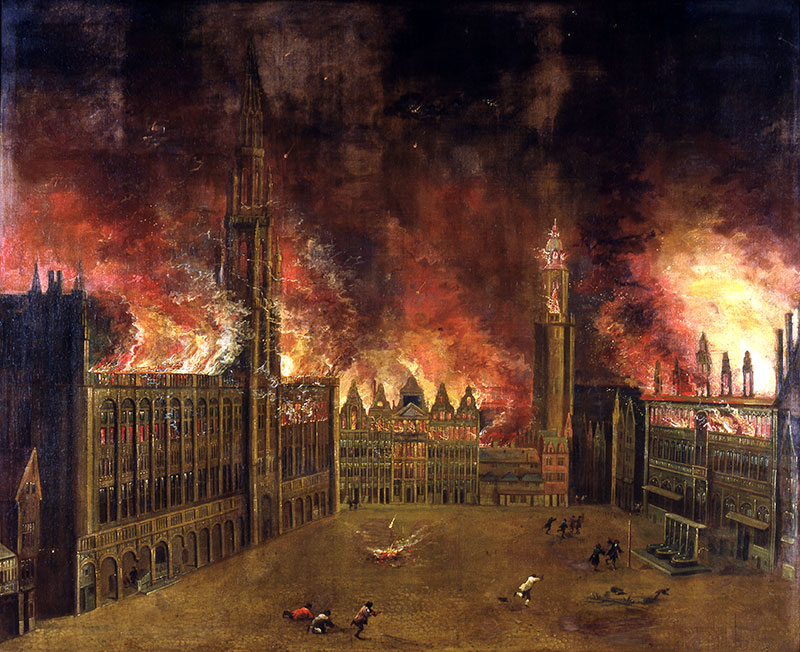
Oil on canvas. Artist unknown. Late 17th C.
Ravaged by flames
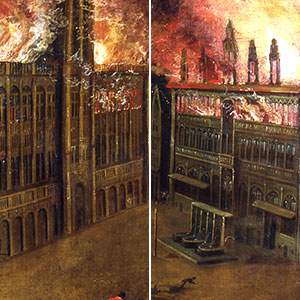 The Grand Place in Brussels falls victim to an apocalyptic fire. The flames lay waste everything in their path and the sky is obscured by black smoke. The City Hall, which is seen on the left, and the King’s House opposite are being consumed by flames from within.
The Grand Place in Brussels falls victim to an apocalyptic fire. The flames lay waste everything in their path and the sky is obscured by black smoke. The City Hall, which is seen on the left, and the King’s House opposite are being consumed by flames from within.
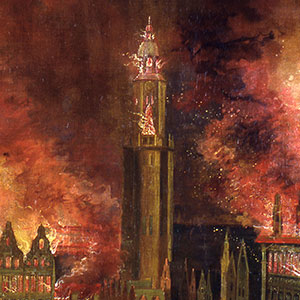 In the background is the steeple of St. Nicholas Church, the top of which is also on fire.
In the background is the steeple of St. Nicholas Church, the top of which is also on fire.
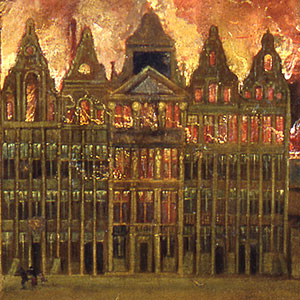 The majority of the stone, brick or half-timbered houses have also been devoured by the flames, which will soon engulf the remaining buildings.
The majority of the stone, brick or half-timbered houses have also been devoured by the flames, which will soon engulf the remaining buildings.
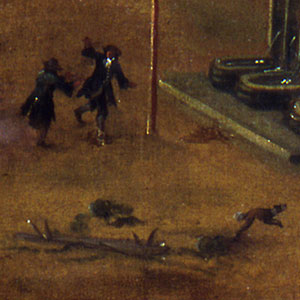 A few people, panic etched on their faces, are trying to flee and a dog can be seen scuttling away on the right.
A few people, panic etched on their faces, are trying to flee and a dog can be seen scuttling away on the right.
A hail of projectiles
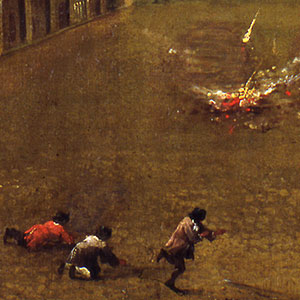 In the foreground, a number of men are petrified by the impact of an incendiary bomb, depicted by the painter as a colourful “halo” in front of them. Between 13 and 15 August 1695, Brussels suffered fierce bombardment by the troops of French king Louis XIV. Incandescent cannonballs and bombs rained down on the lower part of the city, causing the horrific fire depicted here at its height.
In the foreground, a number of men are petrified by the impact of an incendiary bomb, depicted by the painter as a colourful “halo” in front of them. Between 13 and 15 August 1695, Brussels suffered fierce bombardment by the troops of French king Louis XIV. Incandescent cannonballs and bombs rained down on the lower part of the city, causing the horrific fire depicted here at its height.
The historical setting
Louis XIV, driven by the desire to greatly expand his kingdom, is at war against an alliance of European states known as the League of Augsburg. Among them is Spain, whose king Charles II is also the ruler of our regions which, at that time, are known as the Spanish Netherlands. As the biggest city in these territories that have now become a battlefield, Brussels is a very obvious target for the King of France. Louis XIV’s decision to bombard it is intended as a spectacular demonstration of his power and to strike terror into the hearts of his adversaries.
The reconstruction
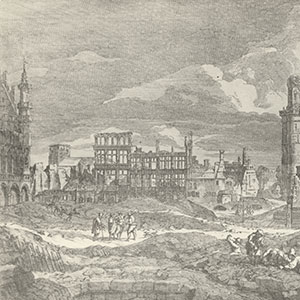 You will see a series of drawings and engravings illustrating the dire state of the ruined city following the bombardment. Around 4,000 houses are estimated to have been destroyed, which was nearly a quarter of the urbanised area.
You will see a series of drawings and engravings illustrating the dire state of the ruined city following the bombardment. Around 4,000 houses are estimated to have been destroyed, which was nearly a quarter of the urbanised area.
 Further on, two long drawings by the artist Derons are the oldest known illustrations of houses on the Grand Place following their reconstruction at the turn of the 18th century. The great care devoted to the architecture of these buildings is a declaration to the world that Brussels has risen gloriously from its ashes after this terrible tragedy.
Further on, two long drawings by the artist Derons are the oldest known illustrations of houses on the Grand Place following their reconstruction at the turn of the 18th century. The great care devoted to the architecture of these buildings is a declaration to the world that Brussels has risen gloriously from its ashes after this terrible tragedy.
Next step
We hope that this guide has helped you better understand some of the works on display in the museum. You can continue exploring the temporary exhibition dedicated to the Grand-Place, or retrace your steps and return to any of the sections that you particularly enjoyed. Thank you for your visit.




